Farnham, Jack Leslie
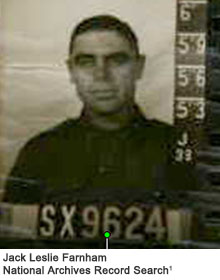 Jack Leslie Farnham, one of 7 children, was born in Athelstone on 10 July, 1904 to parents Elsie May and Wilfred.
Jack Leslie Farnham, one of 7 children, was born in Athelstone on 10 July, 1904 to parents Elsie May and Wilfred.
Jack enlisted in the AIF on 25 July, 1940, stating his occupation as “gardener”, his religion “protestant” and his home address as Paradise. A medical examination deemed him “Fit for Class I” and his height measured at 5'11”. He marched out from Wayville on 30 July, 1940 as part of the 2/3rd Machine Gun Battalion.
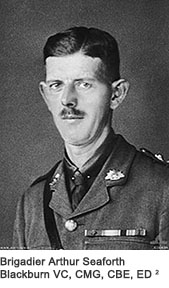 This battalion was formed in June 1940 under the command of Lieutenant Colonel Arthur Blackburn, VC. Although raised in South Australia, it also comprised troops from Victoria, Tasmania and Western Australia. It was not until April 1941 that the battalion came together on board the troopship transporting them to the Middle East.1
This battalion was formed in June 1940 under the command of Lieutenant Colonel Arthur Blackburn, VC. Although raised in South Australia, it also comprised troops from Victoria, Tasmania and Western Australia. It was not until April 1941 that the battalion came together on board the troopship transporting them to the Middle East.1
“The Division is sometimes known by the nickname ”the Silent Seventh”, due to a perception that it’s achievements were unrecognised, in comparison to the other Australian Divisions. The origin of this belief is to be censorship of the part played by the 7th Division in the fierce fighting in the 1941 Syria/Lebanon campaign”.2
Arriving in Suez the 2/3rd MGB joined the 7th Division preparing to invade Syria. Jack disembarked there in April, 1941.
Allied forces began their invasion of Syria on 8 June and were soon engaged in heavy fighting against the Vichy French. Although Syria was a short campaign, the machine-gunners saw extensive service. B Company supported the 25th Brigade, covering the attack on Fort Metulla on 10 June and participating in the fighting around and defence of Jezzine. In mid-June, A Company supported the 2/2nd Pioneer Battalion attack on Fort Merdjayoun, while D Company was attached to the 21st Brigade, which captured Said (Sidon) and Damour. C Company's first action was at Quneitra in support of British units. By the second week of July the campaign was over, with the Vichy French surrendering and a cease fire coming into effect at midnight on 11 July. The machine-gunners remained in Syria as part of the occupation force for the rest of the year.3
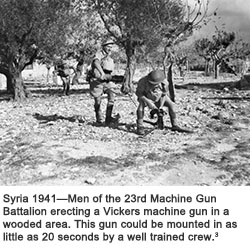 Jack Farnham did not take part in the invasion of Syria, as in June he was evacuated to 7 Australian General Hospital in Palestine and transferred to “X” List. X Lists recorded personnel who were absent from their regular units for various reasons. In July of same year he was discharged from the hospital and transferred to MGT Btn. He was appointed Lance Corporal on 26 August, 1941 whilst in the Middle East.4
Jack Farnham did not take part in the invasion of Syria, as in June he was evacuated to 7 Australian General Hospital in Palestine and transferred to “X” List. X Lists recorded personnel who were absent from their regular units for various reasons. In July of same year he was discharged from the hospital and transferred to MGT Btn. He was appointed Lance Corporal on 26 August, 1941 whilst in the Middle East.4
At the end of January, 1942 Jack embarked from Suez with units from the 7th Division who at the time were heading home to defend Australia.5 However with the fall of Singapore on 15 February, the ship Orcades carrying troops including those of 2/3rd reached Sumatra before going on to Batavia in Java. The decision to send troops to Java proved ultimately to be futile.
Lieutenant Colonel Blackburn was promoted to Brigadier in command of the force comprising Australian, Dutch and American troops. This group, consisting mainly of non-infantry units of the 7th Division AIF became known as Blackforce.
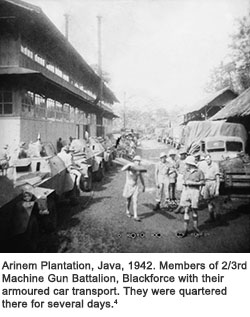 Japanese troops landed on Java on 28 February and on 4 March Blackforce went into action at Leuwiliang, near Buitenzorg. These men had been landed in Java from the Middle East just days before, some of them without their weapons or equipment. For a few days Blackburn, with some awareness of Japanese tactics, mounted a successful holding operation. However, on other battlefronts Allied troops fell back before the Japanese and by 11 March 'Blackforce' was obliged to surrender after Dutch forces capitulated. Its losses numbered about 100 killed or wounded and over 2,700 became prisoners of war.6
Japanese troops landed on Java on 28 February and on 4 March Blackforce went into action at Leuwiliang, near Buitenzorg. These men had been landed in Java from the Middle East just days before, some of them without their weapons or equipment. For a few days Blackburn, with some awareness of Japanese tactics, mounted a successful holding operation. However, on other battlefronts Allied troops fell back before the Japanese and by 11 March 'Blackforce' was obliged to surrender after Dutch forces capitulated. Its losses numbered about 100 killed or wounded and over 2,700 became prisoners of war.6
With the Allied surrender in Java, the Japanese had attained, in just over three months, an empire in the Pacific and south-east Asia. It was to take over three years of war to drive them from it.
In March 1942 Lance Corporal Farnham was reported as missing in action, however the following message was heard via Japanese radio from Batavia in April, 1943.7
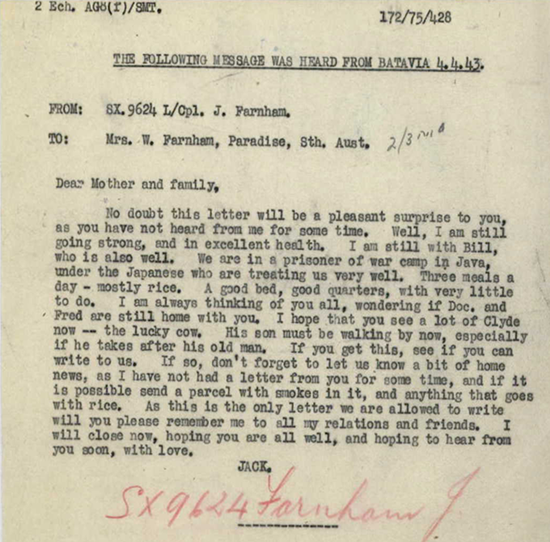
He was appointed a Paid Lance Corporal in July, 1943 whilst a POW in Java.8
Jack’s records show that he next appears as a POW in Thailand in August, 1945. Many of the 2/3rd captured in Java spent the next three years of the war labouring for the Japanese, most working on the infamous Thai-Burma railway or languishing in prison camps. 139 men from 2/3rd died whilst prisoners.
Although there is no definitive list of those who worked on the railway, correspondence from the Information Services of the Australian War Memorial confirms that members of Lance Corporal Farnham’s unit were amongst that group of prisoners and it is reasonable to assume Jack was one of those prisoners.
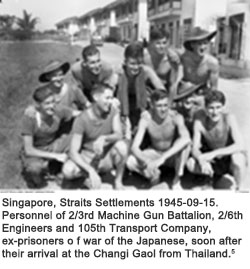 He was “recovered from Japanese at Siam” in August, 1945 and embarked from Singapore on the ”Tamaroa” in September of 1945, arriving in Melbourne in October.9
He was “recovered from Japanese at Siam” in August, 1945 and embarked from Singapore on the ”Tamaroa” in September of 1945, arriving in Melbourne in October.9
Following his discharge from the AIF on 23 January, 1946, Jack Farnham returned to the Paradise area and his previous occupation as a market gardener.
On 9 February, 1946 he married Jean Beatrice Taylor whose family owned a large parcel of land in the Highbury/Dernancourt/Paradise area (part of which was formerly known as Athelstone). This land was subdivided in the mid 1960s for housing developments.
Jack and Jean had two sons, Giles and Dean (a Central Districts’ footballer).
In the late 1960s they moved to Queensland where they purchased a caravan park.
Jack died in Cairns on 16 October, 1985 and along with his wife Jean, is buried in the Athelstone Independent Cemetery.
Researched and compiled by Vaughan Williams & Sue Polkinghorn, from the Campbelltown Library “Digital Diggers” group.
If you have any comments or questions regarding the information in this local history article, please contact the Local History officer on 8366 9357 or hthiselton@campbelltown.sa.gov.au
Text References
- Australian War Memorial, viewed 25 June, 2015 (www.awm.gov.au/unit/U56172/).
- 7th Division (Australia) Wikipedia viewed 25 June, 2015 (http://en.wikipedia.org/wiki/7th_Division_(Australia).
- Australian War Memorial, viewed 25 June, 2015 (www.awm.gov.au/unit/U56172/).
- NAA B883, SX9624 pg. 8, 9, Farnham, J L National Archives of Australia viewed 25 June, 2015 (https://recordsearch.naa.gov.au/SearchNRetrieve/Interface/ViewImage.aspx?B=6407742).
- NAA B883, SX9624 pg. 8, 9, Farnham, J L National Archives of Australia viewed 25 June, 2015 (https://recordsearch.naa.gov.au/SearchNRetrieve/Interface/ViewImage.aspx?B=6407742).
- Australian War Memorial, viewed 25 June, 2015 (www.awm.gov.au/unit/U56172/).
- NAA B883, SX9624 pg. 5, Farnham, J L National Archives of Australia viewed 25 June, 2015 (https://recordsearch.naa.gov.au/SearchNRetrieve/Interface/ViewImage.aspx?B=6407742).
- NAA B883, SX9624 pg. 8, 9, Farnham, J L National Archives of Australia viewed 25 June, 2015 (https://recordsearch.naa.gov.au/SearchNRetrieve/Interface/ViewImage.aspx?B=6407742).
- NAA B883, SX9624 pg. 8, 9, Farnham, J L National Archives of Australia viewed 25 June, 2015 (https://recordsearch.naa.gov.au/SearchNRetrieve/Interface/ViewImage.aspx?B=6407742).
Photo References
- NAA B883, SX9624 pg. 2, Farnham, J L National Archives of Australia viewed 25 June, 2015 (https://recordsearch.naa.gov.au/SearchNRetrieve/Interface/ViewImage.aspx?B=6407742).
- Arthur Blackburn Wikipedia viewed 25 June, 2015 (http://en.wikipedia.org/wiki/Arthur Blackburn)
- Australian War Memorial, viewed 25 June, 2015 (www.awm.gov.au/collection/021169/)
- Australian War Memorial, viewed 25 June, 2015 (www.awm.gov.au/collection/043856/)
- Australian War Memorial, viewed 25 June, 2015 (www.awm.gov.au/collection/043856/)
